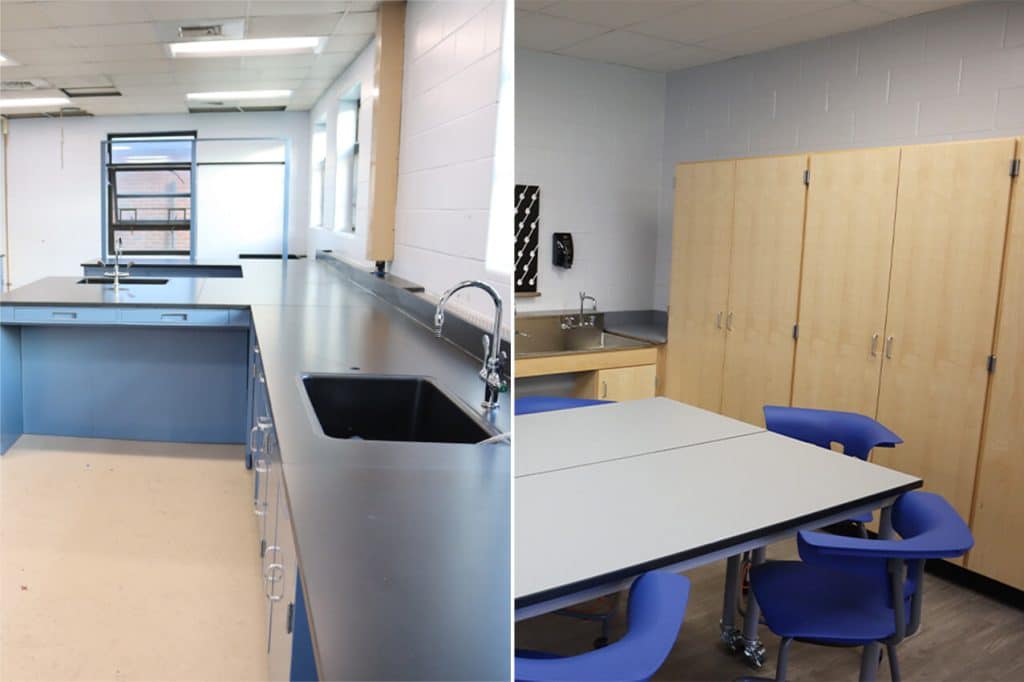Is Wooden Casework or Steel Casework the Better Option for Science Labs?

Steel vs Wood: Which is better for Science Lab Renovation Projects?
When it comes to casework for science classrooms and laboratories, it is important to choose a high quality material that meets the structural requirements for laboratory use. While there is a common misconception that steel is a sturdier and more viable option than wood, in reality both of these materials are strong and are deemed to meet the customer-defined requirements for lab usage. In fact, these two materials are both tested to the same structural requirements by the Scientific Equipment & Furniture Association (SEFA). Considering this, as well as the fact that steel casework is commonly perceived to be the better option, are the two materials actually equally sound choices or could wood even be the better option overall?
Here at Longo Labs we specialize in turning visions into realities for classroom and commercial laboratory renovations and casework is one of our areas of expertise. Today, we would like to discuss the benefits of choosing wooden casework and the misconception of steel casework being the better option.
Iron Ore is Recyclable, while Wood is Renewable
If you have read our blog before, then you have likely seen at least one of our posts about our lab renovation projects. We work with commercial labs, school systems, and other organizations who are in need of casework for their labs. One thing that people frequently say is that they prefer steel casework because steel is a recyclable material. While this is true, it is not the whole truth. Yes, steel is a recyclable material, but that does not make it the better option as a solution for the environment.
Using wood products is a form of renewable energy. According to the Office of Energy Efficiency and Renewable Energy, renewable energy generates about 20% of electricity in the United States. Renewable energy also has benefits that involve human health, the environment, the economy, and even our national security. Wood is a form of bioenergy, which is energy produced from biomass or plant-based materials. As opposed to iron ore, which is finite and will eventually run out, renewable energy comes from materials like wood that are replenished naturally and will not run out one day. Therefore, while it is good to recycle steel and other finite materials, using renewable materials is actually the better option for the environment.
Using Wood Products Cleans the Environment
When using a renewable product like wood, not only is it less harmful for the environment that steel, it is in fact good for the environment. Old trees that are cut down for materials tend to store carbon, while young trees that are freshly planted to replace them tend to absorb carbon. The very act of replenishing the tree populations is helping to clean the environment by removing carbon-storing old trees and replacing them with young trees that are removing carbon dioxide from the air while they absorb the carbon as their plant food. This is obviously not the case with mineral deposits, such as iron ore. Although trees are an important part of human survival as well as natural animal habitats, the process of cutting them down and replenishing them with young, healthy trees helps to clean the environment.
Wood is the More Energy Efficient Option
Putting it simply, it takes about seven times as much energy to create steel as it does to create usable wood material. If you were to create a kilogram of steel it would take 20-50 megajoules of energy, however recycling steel only requires 6-15 megajoules! While this sounds great, you must consider the fact that the energy was already used to make the steel in the first place, and it is now additional energy consumption to recycle it. It only takes 3-7 megajoules of energy in the first place for you to create a kilogram of usable wood materials, meaning that even recycling steel is less energy efficient than creating new wood materials.
Not only is it a lower use of energy, but there are far fewer greenhouse gas emissions in the manufacturing of wood products than there are in the manufacturing of steel products. Steel production results in more pollution, even when recycled. If environmental impact is part of your decisions of choosing wood or steel casework, then hopefully you now see why wood casework is the superior option.
Are You Planning a Lab Renovation Project? Let Us Help!
While we strongly recommend our wood casework products, the team here at Longo Labs does much more than just casework. From planning and design to execution, our team is here to help you renovate your laboratory. Get in touch with us or schedule a consultation with our team. Our goal is to help turn your vision into a reality and help you plan, design, and install your commercial or educational lab renovation project.
